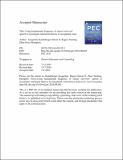Files in this item
Using fundamental frequency of cancer survivors’ speech to investigate emotional distress in out-patient visits
Item metadata
| dc.contributor.author | Kandsberger, Jacqueline | |
| dc.contributor.author | Rogers, Simon | |
| dc.contributor.author | Zhou, Yuefang | |
| dc.contributor.author | Humphris, Gerald Michael | |
| dc.date.accessioned | 2017-08-02T23:33:59Z | |
| dc.date.available | 2017-08-02T23:33:59Z | |
| dc.date.issued | 2016-12 | |
| dc.identifier | 244740898 | |
| dc.identifier | b7c5d0d1-ec61-4c4e-bc72-a760aff96acc | |
| dc.identifier | 84995678232 | |
| dc.identifier | 000391223200007 | |
| dc.identifier.citation | Kandsberger , J , Rogers , S , Zhou , Y & Humphris , G M 2016 , ' Using fundamental frequency of cancer survivors’ speech to investigate emotional distress in out-patient visits ' , Patient Education and Counseling , vol. 99 , no. 12 , pp. 1971–1977 . https://doi.org/10.1016/j.pec.2016.08.003 | en |
| dc.identifier.issn | 0738-3991 | |
| dc.identifier.other | ORCID: /0000-0002-4601-8834/work/64033940 | |
| dc.identifier.uri | https://hdl.handle.net/10023/11361 | |
| dc.description.abstract | Objective Emotions, are in part conveyed by varying levels of fundamental frequency of voice pitch (f0). This study tests the hypothesis that patients display heightened levels of emotional arousal (f0) during Verona Coding Definitions of Emotional Sequences (VR-CoDES) cues and concerns versus during neutral statements. Methods The audio recordings of sixteen head and neck cancer survivors’ follow-up consultations were coded for patients’ emotional distress. Pitch (f0) of coded cues and concerns, including neutral statements was extracted. These were compared using a hierarchical linear model, nested for patient and pitch range, controlling for statement speech length. Utterance content was also explored. Results Clustering by patient explained 30% of the variance in utterances f0. Cues and concerns were on average 13.07 Hz higher than neutral statements (p = 0.02). Cues and concerns in these consultations contained content with a high proportion of recurrence fears. Conclusion The present study highlights the benefits and challenges of adding f0 and potential other prosodic features to the toolkit of coding emotional distress in the health communication setting. Practice implications The assessment of f0 during clinical conversations can provide additional information for research into emotional expression. | |
| dc.format.extent | 1025952 | |
| dc.language.iso | eng | |
| dc.relation.ispartof | Patient Education and Counseling | en |
| dc.subject | Emotional distress | en |
| dc.subject | The VR-CoDES | en |
| dc.subject | Fundamental frequency of pitch | en |
| dc.subject | Multilevel | en |
| dc.subject | Head and neck cancer | en |
| dc.subject | L Education | en |
| dc.subject | RC0254 Neoplasms. Tumors. Oncology (including Cancer) | en |
| dc.subject | NDAS | en |
| dc.subject | SDG 3 - Good Health and Well-being | en |
| dc.subject.lcc | L | en |
| dc.subject.lcc | RC0254 | en |
| dc.title | Using fundamental frequency of cancer survivors’ speech to investigate emotional distress in out-patient visits | en |
| dc.type | Journal article | en |
| dc.contributor.institution | University of St Andrews. School of Medicine | en |
| dc.contributor.institution | University of St Andrews. WHO Collaborating Centre for International Child & Adolescent Health Policy | en |
| dc.contributor.institution | University of St Andrews. Health Psychology | en |
| dc.contributor.institution | University of St Andrews. St Andrews Sustainability Institute | en |
| dc.identifier.doi | 10.1016/j.pec.2016.08.003 | |
| dc.description.status | Peer reviewed | en |
| dc.date.embargoedUntil | 2017-08-02 |
This item appears in the following Collection(s)
Items in the St Andrews Research Repository are protected by copyright, with all rights reserved, unless otherwise indicated.

